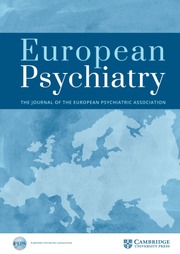No CrossRef data available.
Article contents
Nonbenzodiazepine versus benzodiazepine hypnotic efficiency analysis in older people
Published online by Cambridge University Press: 16 April 2020
Abstract
Poor sleep quality causes frequently and seriously impairments in older people daily functioning. More than that, inadequate treatment of insomnia side effects further decrease patients quality of life.
We examined whether between nonbenzodiazepine and benzodiazepine hypnotic treatment are significant differences regarding sleep quality, total sleep time, sleep onset latency, number of awakenings during the night, global functioning and side effects.
A group of 40 outpatients, 16 male and 24 female, mean age 67.9, diagnosed with insomnia, was divided in two equally groups, each of them receiving for at least 7 days either zolpidem 5 mg/day or diazepam 10 mg/day, overnight. Inclusion criteria: age over 65. Exclusion criteria: physical illness and psychiatric disorders that disrupt sleep, simultaneous administration of other sedative drugs. An assessment using Clinical Global Impressions (CGI), Global Assessment of Functioning (GAF) and self reports for depth, total perceived time, onset latency of sleep, number of awakenings during night and side effects were realised every day for a week.
The intent-to-treat (ITT) and last-observation-carried-forward (LOCF) analysis reflected statisticaly significant differences from the day 2 in four variables- depth of sleep (+3/+1.2, p<0.01), number of awakenings(+3.2/+4.9, p<0.01), GAF (+7.8/+5.5, p<0.01) and CGI (-1.9/-0.7, p<0.01) in favor of zolpidem treated patients. Also, side effects were significantly more frequent reported in benzodiazepine group (15/10, dropouts 3/1, p<0.01).
Zolpidem is a first choice treatment in older people because it is well tolerated and have a good efficacy profile compared to diazepam.
- Type
- Poster Session 2: Anxiety, Stress Related, Impulse and Somatoform Disorders
- Information
- European Psychiatry , Volume 22 , Issue S1: 15th AEP Congress - Abstract book - 15th AEP Congress , March 2007 , pp. S289
- Copyright
- Copyright © European Psychiatric Association 2007



Comments
No Comments have been published for this article.